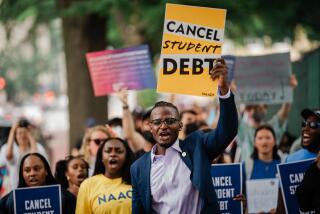U.S. to share profit, risk in bank plan
- Share via
WASHINGTON — Although the formal unveiling is still a couple of weeks away, the broad outlines of President Obama’s long-delayed plan for reviving the nation’s financial system are coming clear: an ambitious but untested attempt to partner up private capital with government funds while limiting the risk to taxpayers.
Under the emerging plan, Washington would finance the creation of several investment funds charged with buying up to $1 trillion of the toxic mortgage-backed securities and other bad assets now corroding the books of huge financial institutions such as Citigroup Inc.
Money to purchase the assets would come from the government, in partnership with private investors. It’s not yet clear how large Washington’s contribution would be or the ratio of tax dollars to private capital.
The bigger the federal commitment, the bigger the potential cost to taxpayers -- and the more open the plan will be to criticism that it amounts to a bailout for Wall Street moguls who were largely responsible for creating the crisis in the first place.
If the plan succeeds in attracting private funds to share the cost of soaking up the tainted securities, the big banks and other financial institutions would presumably regain their strength. Then they would be free to resume the lending and other activities considered essential if the nation and the global economy are to recover from the current crisis.
“Until we fix financial markets, the stimulus won’t be that stimulating,” said Gregory Hess, a professor of public finance and dean of academic affairs at Claremont McKenna College. “You don’t fix the markets, you don’t fix the problem.”
Eventually, as the economy recovers, at least some of the now-toxic assets will regain value and taxpayers could recoup some or all of the government’s investment.
If the plan doesn’t work, the government might have to resort to one of the more aggressive remedies, such as buying the assets outright or nationalizing the banks. That could put taxpayers on the hook for substantial losses.
Those approaches would also risk damaging a broad array of investors, including the pension plans and mutual funds that tend the nest eggs of working Americans.
The effort to avoid these options drove the administration to its hybrid approach, and its complexity has delayed the announcement of a detailed plan expected more than a month ago.
The new plan is designed to address the fact that major financial institutions still hold huge inventories of mortgage-backed securities that are almost impossible to sell in today’s market. The banks have already taken billions of dollars of losses on these assets, and investors and the banks themselves fear more such hits.
Hess, of Claremont McKenna, noted that the bad securities are composed largely of the mortgages of millions of Americans, only some of whom have defaulted. The problem is that the mortgages were chopped up and mixed together and can’t be put back the way they were.
“If you’ve made sausage, can you put the meat back together again? But even if there’s only one small bit of the sausage that’s bad, you’re not going to want to eat the sausage,” Hess said. “You can’t undo it. So what you have to do is create a new market for questionable sausage. And in the end, everyone is going to have to hold their nose and eat some of it.”
Administration officials believe that with adequate government backing, experienced traders with a long-term perspective will be willing to buy mortgage-backed securities, expecting that at least some of the investments will pay off.
The plan will use “market mechanisms to help clean up the legacy assets on bank balance sheets,” Treasury Secretary Timothy F. Geithner told lawmakers last week. “This program will be designed to bring in private capital alongside government financing to help restart markets for these assets.”
Administration officials say they have received private assurances that at least some big investors would participate, but such a strategy has never been tried and there’s no guarantee it will work.
Critics have accused the administration of in effect offering to bankroll risk-seeking outfits, including hedge funds and private equity groups. But government officials said they expected their partners to come from the ranks of long-term investors such as pension funds and endowments.
“We do not yet know which investors will come to the partnership,” Neel Kashkari, the assistant Treasury secretary who is helping to draft the program, told lawmakers last week. “But my expectation is you will see pension plans coming, you will see people’s retirement funds [get involved] through mutual fund-type organizations. . . . There may be some well-known investors that people recognize.”
Kashkari insisted that all risks and gains would be shared between the government and private investors.
“The taxpayer dollars are side-by-side . . . with the private sector’s dollars,” Kashkari said. “So if the private sector wins, the taxpayers win. If the taxpayer loses, the private sector loses. By perfectly aligning our interests, we think that may be the best way to protect taxpayers.”
The plan will be the third and final piece of Obama’s “three-legged stool” of economic recovery programs. The first part was the stimulus spending plan approved by Congress last month. The second was the housing program to spur refinancing and curb foreclosures.
Administration officials say the plan will be able to get started without new funding from Congress.
--
jim.puzzanghera@latimes.com
More to Read
Inside the business of entertainment
The Wide Shot brings you news, analysis and insights on everything from streaming wars to production — and what it all means for the future.
You may occasionally receive promotional content from the Los Angeles Times.











